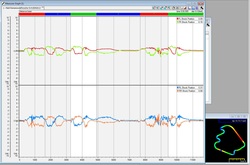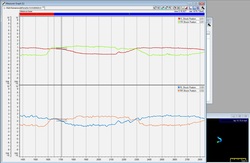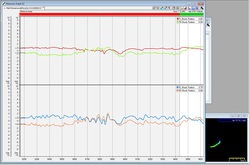
Check out this trace and see what you notice. The top graph is the front shock positions and the bottom is the rear shock positions.

When we zoom into a smaller one corner section, we can see the same thing happening. You can see the front shock position move to a certain position and then it doesn’t change much. At the rear, we can see that even when it goes approaches the limit of how compressed it will be, it still has a number of small movements. Those small movements are the car absorbing small road irregularities when loaded for a corner.

When analyzing your data, you have to compare what you are actually getting to what you would expect. In this case, you expect the suspension to always be absorbing bumps, so when it stops doing that, you have to look at why. This applies to many areas, like lateral acceleration to each side – they should be roughly equal for equal turns, engine speed to wheel speed – the clutch shouldn’t be slipping, steering angle to lateral G – a rough over/understeer measurement, and many more items. The more ways you can dig into your data, the more you will get out of it and the faster you can go.

 RSS Feed
RSS Feed
